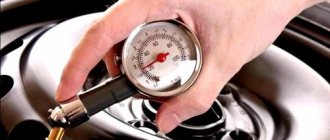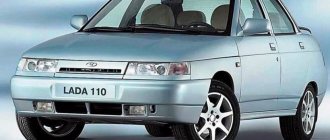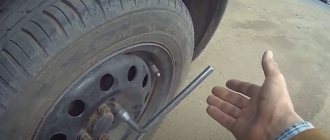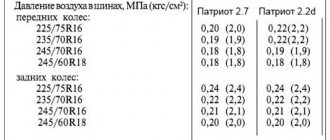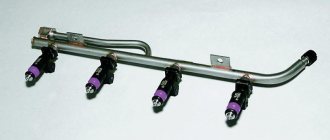Author: Peter Glukhov, editor Published: 05/24/2021 Updated: 05/30/2021
Fuel consumption is higher than usual, unusually sluggish handling, underbody grinding where you have always driven without problems - all this may be due to incorrect tire pressure. And pressure above or below normal reduces the life of the tire and increases the risk of damage. Avoiding these problems means keeping in mind what the tire pressure should be, checking it regularly and adjusting it if necessary.
How to find out the correct tire pressure for your car?
Instructional materials for each car model contain a number of important parameters that must be observed for safe operation of the vehicle. Among them is the tire pressure value. It may vary depending on the tire size and season. The specified value must be observed, avoiding significant deviations (more than 10%).
Optimal pressure not only contributes to safe movement, but also makes driving more comfortable. If the correct values are observed, the tread is in full contact with the road surface, providing maximum traction. At the same time, the car handles well, clearly responds to all driver actions, and is stable when cornering.
To determine the optimal tire pressure for a particular model, the automaker conducts extensive tests and engineers carry out complex calculations. In this case, the values are determined separately for the cold and hot seasons. This is because air pressure changes depending on temperature. The specific value of the parameter is influenced by the following factors:
- wheel diameter;
- axle weight distribution;
- total weight of the vehicle and its carrying capacity;
- tire type according to the time of year.
You can find out the correct tire pressure for your vehicle in your owner's manual. Also, this parameter is usually indicated on special plates, which can be found either in the front door opening on the driver’s side or on the fuel tank hatch.
Data for the front and rear wheels are indicated separately. If in the future the car owner makes design changes to his car that affect the above factors, the pressure value will need to be adjusted.
It must be taken into account that during the operation of the vehicle the pressure value changes. For example, when a tire heats up, the air expands and the pressure increases . Therefore, when driving at high speeds and sharp braking, the effect of overinflated tires occurs. When calculating the correct pressure value, the manufacturer takes into account various driving modes. And the car owner must independently adjust the pressure depending on specific situations.
When driving on soft ground, it is recommended to lower the tire slightly to ensure better contact between the tread and the road surface. The next time you drive onto hard surfaces, you need to re-inflate the tire to the required level. If you plan to load the vehicle as much as possible, you will need to inflate the wheel to the level recommended by the manufacturer for such situations.
What are the dangers of driving on improperly inflated tires?
Many novice motorists have the misconception that an overinflated tire is preferable to an underinflated one. An argument for this can be that on hypercars the tire pressure is usually higher than normal. In fact, any pressure deviation from normal values has an equally negative effect on the tires. Thus, with insufficient pressure, the contact area of the tread with the road surface increases, which causes greater wear at the edges.
Insufficient tire pressure is indicated by:
- increased fuel consumption by 10-20%;
- cornering with great effort;
- the car moves to the side when driving at speeds above 50 km/h.
When the normal pressure value is exceeded, the tread has a smaller contact area with the blade, therefore increased wear is observed in the center. Tire pressure that is too high is indicated by:
- loss of control when cornering;
- car jumps at speeds above 60 km/h (if the wheel hits a pothole or runs over a rock, the tire may be damaged);
- suspension operation in overloaded mode;
- increased noise in the cabin.
When the vehicle is at maximum load, do not over-inflate the wheels. Some car enthusiasts do this, mistakenly believing that the load needs to be compensated by pumping.
Sealing mixtures and armor
In case of “catching a nail”, there are various mixtures. You just need to pump them into the wheel in advance, after which you can safely drive to the tire shop. Tires have long been invented that can continue moving, even if there is no air in them.
These are the so-called hard side tires. On such tires, if there is a puncture or valve failure, you can drive at speeds of up to 80 km/h. The car maintains maneuverability and stability in turns. These tires are called Run Flat.
Armored limousines are equipped with wheels equipped with special rims and inserts-bandages consisting of high-strength metal or plastic. Even if the car explodes or the tires are deformed, they can travel a very significant distance at a speed of 60-80 km/h. Of course, such wheels are an expensive pleasure.
Pressure units
bar (atm)
In European countries and the former Soviet Union, bars (bar) or atmospheres (atm) are used to measure tire pressure. It is indicated in kgf/cm2. The measurement is carried out with a pressure gauge. The error of this device is approximately 1-2%. In fact, bars are somewhat different from atmospheres, the formula looks like this:
bar = 0.980655 x atm
Usually this minor difference is neglected.
kPa
If you see an inscription in kilopascals on your tire, then we are not talking about the recommended value of pressure in the wheel, but about the maximum permissible. The text on the sidewall will look like this: max pressure and then the value in numbers.
This value is translated into familiar atmospheres or bars using the following formula:
bar = kPa / 101.325
To convert bars or atmospheres to kilopascals you need to use the following formula:
kPa = bar x 101.325
convert kPa to psi:
psi = kPa / 6.89476
To convert psi to kilopascals you need to apply this formula:
kPa = psi x 6.89476
psi
The USA uses its own system - psi. It is based on the units used here - pounds and inches. That is, the pressure value is indicated as psi.
psi = bar x 14.706
bar (atm) = psi x 0.068
Examples
1. Let's say your car has a recommended tire pressure of 33 psi. Let's determine how much is this in atmospheres?
atm = psi x 0.068 = 33 x 0.068 = 2.244
That is approximately 2.2 atm (or bar).
2. Let your tire say “Max pressure 400 kPa”. To convert into our usual values, we use the following equation:
bar (atm) = kPa / 101.325 = 400 / 101.325 = 3.9476
That is, approximately 4 “kilograms”, 4 atm (or bar).
To convert from the European standard to the American standard and to kPa, you can use the following table:
| Converting pressure from atmospheres (atm) and bars (bar) to psi and kilopascals (kPa) | ||
| psi | atm (bar) | kPa |
| 20 | 1.36 | 137.895 |
| 21 | 1.428 | 144.790 |
| 22 | 1.496 | 151.685 |
| 23 | 1.564 | 158.579 |
| 24 | 1.632 | 165.474 |
| 25 | 1.7 | 172.369 |
| 26 | 1,768 | 179.264 |
| 27 | 1.836 | 186.159 |
| 28 | 1.904 | 193.053 |
| 29 | 1.972 | 199.948 |
| 30 | 2.04 | 206.842 |
| 31 | 2.108 | 213.738 |
| 32 | 2.176 | 220.632 |
| 33 | 2.244 | 227.527 |
| 34 | 2.312 | 234.422 |
| 35 | 2.38 | 241.317 |
| 36 | 2.448 | 248.211 |
| 37 | 2.516 | 255.106 |
| 38 | 2,584 | 262.001 |
| 39 | 2.652 | 268.896 |
| 40 | 2.72 | 275.79 |
| 41 | 2.788 | 282.685 |
| 42 | 2.856 | 289.58 |
| 43 | 2.924 | 296.475 |
| 44 | 2.992 | 303.369 |
| 45 | 3.06 | 310.264 |
| 46 | 3.128 | 317.159 |
| 47 | 3.196 | 324.054 |
| 48 | 3.264 | 330.948 |
| 49 | 3.332 | 337.843 |
| 50 | 3.4 | 344.738 |
| 51 | 3.468 | 351.633 |
| 52 | 3.536 | 358.528 |
| 53 | 3.604 | 365.422 |
| 54 | 3.672 | 372.317 |
| 55 | 3.74 | 379.212 |
| 56 | 3.808 | 386.107 |
| 57 | 3.876 | 393.001 |
| 58 | 3.944 | 399.896 |
| 59 | 4.012 | 406.791 |
If the air temperature drops to values less than +10°C, then the tire pressure drops by about 10%. In hot weather, the parameter, on the contrary, increases by the same amount. Therefore, this feature must be taken into account when taking measurements in winter and summer.
Why are the pressure values different for different axes?
Among specialists, such a concept as weight distribution along the axes is common. Its essence lies in the fact that due to the design features, the mass of the car is distributed unevenly along the axes.
Weight distribution along axes
Weight distribution differs for different car brands. For example, the VAZ 2108 is characterized by the following parameters:
- unloaded vehicle weight - 927 kg;
- front axle load - 565 kg (61%);
- load on the rear axle - 362 kg (39%).
The weight distribution for other models will be slightly different - see the weight distribution for almost a thousand European, American, Japanese and Korean cars in the file:
| Weight distribution along the car axes, almost 1000 models from European, American, Korean and Japanese manufacturers. Download the pdf file, 1.67MB (click on the icon). |
Since the front axle is usually loaded more than the rear, the wheels in front need to be inflated a little more. What tire pressure should be on the front and rear axles is determined by the car manufacturers themselves. These indicators can be found in the table below.
What tire pressure should be in summer and winter?
In cold weather conditions, additional tire inflation is required. This is due to the fact that at sub-zero temperatures the air compresses. Accordingly, the wheel will be underinflated. Therefore, in winter, it is necessary to inflate the tire, bringing the indicator to the value recommended by the manufacturer. Usually it is enough to increase the pressure by 0.2-0.3 atmospheres.
It is necessary to slightly increase the tire pressure even when the car is fully loaded. It is enough to increase it by 0.1 atmospheres. You should not over-inflate the wheel; this will not improve the car's handling in any way.
Summary data on tire pressure in winter and summer are presented in the table:
Table
| car brand | Dimensions | Pressure (front/rear) |
| vaz/lada | ||
| 2104 | 165/80 R13 | 1.6/2.1 |
| 175/70 R13 | 1.6/2.2 | |
| 2106 | 165/80 R13 | 1.6/1.9 |
| 175/70 R13 | 1.7/2.0 | |
| 165/70 R13 | 1.8/2.1 | |
| 2107 | 165/80 R13 | 1.6/1.9 |
| 175/70 R13 | 1.7/2.0 | |
| 2109/21099 | 165/70 R13 | 1.9/1.9 |
| 175/70 R13 | 1.9/1.9 | |
| 155/80 R13 | 1.9/1.9 | |
| 2110/2111/2112 | 175/70 R13 | 1.9/1.9 |
| 175/65 R14 | 1.8/1.8 | |
| 185/60 R14 | 1.8/1.8 | |
| 2114/2115 | 165/70 R13 | 1.9/1.9 |
| 175/70 R13 | 1.9/1.9 | |
| vesta | 185/65 R15 | 2.1/2.1 |
| 195/55 R16 | 2.1/2.1 | |
| granta | 175/70 R13 | 1.9/2.1 |
| 175/65 R14 | 2.0/2.2 | |
| Granta liftback | 175/65 R14 | 2.0/2.2 |
| 185/60 R14 | 2.0/2.2 | |
| 185/55 R15 | 2.0/2.2 | |
| viburnum (kalina) | 175/70 R13 | 1.9/1.9 |
| Kalina station wagon/hatchback | 185/60 R14 | 1.9/1.9 |
| priora | 175/70 R13 | 1.9/1.9 |
| 185/60 R14 | 1.9/1.9 | |
| Largus/Largus cross | 185/70 R14 | 2.4/2.6 |
| 185/65 R15 | 2.4/2.6 | |
| Niva | ||
| 2121/21213/21214/2131 | 175/80 R16 | 2.1/1.9 |
| 185/75 R16 | 2.1/2.0 | |
| gas | ||
| 3110/31105 | 195/65 R15 | 2.0/2.1 |
| 3307/3309 | 8.25R20 | 4.5/6.3 |
| 3308 | 12.00R18 | 3.5/4.5 |
| 53 | 8.25R20 | 4.0/6.3 |
| 66 | 8.00R18 | 2.8/2.8 |
| gazelle | ||
| 2705 (business) | 185/75 R16 | 3.0/3.0 |
| 3302 (cargo) | 185/75 R16 | 3.0/3.0 |
| next | 185/75 R16 | 3.6/2.9 |
| passenger | 185/75 R16 | 3.0/3.0 |
| sable | 215/65 R16 | 2.7/2.7 |
| sable 2752 | 185/75 R16 | 3.3/3.9 |
| Valdai | 215/75 R17 | 5.4/6.3 |
| lawn next | 185/75 R16 | 3.3/3.9 |
| zil | ||
| 130/131 | 9.00R20 | 4.5/6.0 |
| 5301 (bull) | 225/75 R16 | 5.0/6.0 |
| UAZ | ||
| 469 | 235/70R16 | 2.0/2.3 |
| patriot | 225/75R16 | 2.0/2.4 |
| 235/70R16 | 1.9/2.2 | |
| 245/70R16 | 1.8/2.1 | |
| 245/60R18 | 1.8/2.0 | |
| loaf | 225/75R16 | 2.0/2.3 |
| hunter | 225/75R16 | 2.0/2.3 |
| 235/70R16 | 2.1/2.4 | |
| KAMAZ | ||
| 4308 | 245/70R19.5 | 4.8/4.8 |
| 4310 | 245/70R19.5 | 4.8/4.8 |
| 43118 | 425/85R21 | 5.6/5.6 |
| other | ||
| maz | 235/75R17.5 | 6.5/7.3 |
| oka | 135/80R12 | 1.8/1.8 |
| Ural 4320 | 390/95R20 | 4.0/4.0 |
| groove 32053 | 245/70R19.5 | 5.6/4.6 |
| audi | ||
| a4 | 225/50R17 | 2.3/2.3 |
| 235/40R18 | 2.5/2.5 | |
| 245/45R17 | 2.2/2.1 | |
| q5 | 235/65R17 | 2.1/2.1 |
| 235/60R18 | 2.1/2.1 | |
| 235/55R19 | 2.1/2.1 | |
| 255/45R20 | 2.1/2.1 | |
| bmw | ||
| x5 | 235/65R17 | 2.2/2.2 |
| 255/55R18 | 2.2/2.2 | |
| 255/50R19 | 2.1/2.5 | |
| e39 | 225/60R15 | 2.0/2.2 |
| 205/65R15 | 2.2/2.4 | |
| 235/40R18 | 1.9/2.3 | |
| 265/35R18 | 2.3/2.7 | |
| 225/55R16 | 2.3/2.7 | |
| 235/45R17 | 2.5/2.7 | |
| x1 | 225/50R17 | 2.2/2.7 |
| 225/45R18 | 2.5/2.7 | |
| daewoo | ||
| matiz | 145/70R13 | 1.9/1.9 |
| 155/65R13 | 1.9/1.9 | |
| nexia | 175/70R13 | 2.0/2.1 |
| 185/60R14 | 2.2/2.4 | |
| dodge | ||
| caliber | 215/60R17 | 2.2/2.2 |
| 215/55R18 | 2.2/2.2 | |
| 225/45R19 | 2.2/2.2 | |
| caravan | 215/65R15 | 2.2/2.3 |
| ford | ||
| focus 3 | 195/65R15 | 2.1/2.1 |
| 205/55R16 | 2.1/2.1 | |
| 205/50R17 | 2.1/2.1 | |
| 225/40R18 | 2.1/2.1 | |
| kuga | 235/55R17 | 2.4/2.4 |
| 235/50R18 | 2.3/2.3 | |
| 235/45R19 | 2.3/2.3 | |
| mondeo 4 | 185/65R14 | 2.1/2.1 |
| 195/60R14 | 2.1/2.1 | |
| 205/55R15 | 2.1/2.1 | |
| transit | 195/70R15 | 3.4/2.7 |
| 195/65R16 | 3.7/4.0 | |
| 205/75R16 | 3.0/3.9 | |
| 215/75R16 | 3.0/4.0 | |
| focus 1 | 185/65R14 | 2.2/2.2 |
| 195/55R15 | 2.0/2.0 | |
| 205/50R16 | 2.2/2.2 | |
| 185/60R15 | 2.2/2.2 | |
| 215/40R17 | 2.2/2.2 | |
| focus 2 | 195/65R15 | 2.1/2.1 |
| 205/55R16 | 2.1/2.1 | |
| 225/40R18 | 2.1/2.1 | |
| fusion | 195/60R15 | 2.4/2.2 |
| 195/55R16 | 2.4/2.2 | |
| Explorer 5 | 235/75R15 | 2.1/2.4 |
| 225/70R15 | 2.1/2.4 | |
| fiat (fiat) | ||
| ducato | 195/70R15 | 4.1/4.5 |
| 205/70R15 | 4.1/4.5 | |
| 215/75R16 | 4.5/4.5 | |
| Jeep (jeep) | ||
| Grand Cherokee | 225/75R16 | 2.3/2.3 |
| 235/65R17 | 2.3/2.3 | |
| 235/70R16 | 2.3/2.3 | |
| 245/60R18 | 2.3/2.3 | |
| Hyundai | ||
| 78 | 175/60R14 | 2.3/2.3 |
| 175/50R15 | 2.3/2.3 | |
| ix35 | 215/70R16 | 2.3/2.3 |
| 225/60R17 | 2.3/2.3 | |
| accent | 155/80R13 | 2.1/2.1 |
| 185/60R14 | 2.1/2.1 | |
| 175/70R14 | 2.1/2.1 | |
| 195/55R15 | 2.1/2.1 | |
| Creta (Greta) | 215/65R16 | 2.3/2.3 |
| porter 2 (portrer) | 185/80R14 | 3.0/4.5 |
| solaris | 185/65R15 | 2.2/2.2 |
| 195/55R16 | 2.2/2.2 | |
| tucson | 215/65R16 | 2.1/2.1 |
| 235/60R16 | 2.1/2.1 | |
| getz | 155/80R13 | 2.1/2.1 |
| 175/65R14 | 2.1/2.1 | |
| 185/55R15 | 2.1/2.1 | |
| santa fe | 215/70R15 | 2.1/2.1 |
| 225/70R16 | 2.1/2.1 | |
| 235/70R16 | 2.1/2.1 | |
| 235/60R18 | 2.1/2.1 | |
| Chery | ||
| Cherie Tiggo (tiggo) | 225/65R17 | 2.3/2.3 |
| Chevrolet | ||
| aveo | 155/80R13 | 2.1/2.1 |
| 185/60R14 | 2.1/2.1 | |
| 195/65R15 | 2.5/2.5 | |
| 205/55R16 | 2.5/2.5 | |
| cobalt | 185/75R14 | 2.5/2.5 |
| 195/65R15 | 2.4/2.4 | |
| lanos | 175/70R13 | 2.2/2.2 |
| 185/60R14 | 2.2/2.2 | |
| Lacetti | 195/55R15 | 2.3/2.3 |
| Chevy Niva | 205/65R15 | 2.1/2.1 |
| 205/70R15 | 2.1/2.1 | |
| 215/65R16 | 2.2/2.2 | |
| captiva | 215/70R16 | 2.1/2.1 |
| 235/55R18 | 2.1/2.1 | |
| Cruze | 205/60R16 | 2.2/2.2 |
| 215/55R17 | 2.2/2.2 | |
| Kia | ||
| picanto | 155/70R13 | 2.1/2.1 |
| 165/60R14 | 2.1/2.1 | |
| 175/50R15 | 2.1/2.1 | |
| rio | 155/80R13 | 2.1/2.1 |
| 175/70R13 | 2.1/2.1 | |
| 175/70R14 | 2.1/2.1 | |
| 185/65R15 | 2.1/2.1 | |
| 195/55R15 | 2.2/2.2 | |
| 195/55R16 | 2.2/2.2 | |
| seed | 185/65R15 | 2.2/2.2 |
| 225/45R17 | 2.2/2.2 | |
| sorento | 225/75R16 | 2.5/2.5 |
| 245/70R16 | 2.5/2.5 | |
| 235/65R17 | 2.2/2.2 | |
| 235/60R18 | 2.3/2.3 | |
| sportage (3, 4, 2016) | 205/70R15 | 1.8/1.8 |
| 215/65R16 | 2.1/2.1 | |
| 235/60R16 | 2.1/2.1 | |
| 215/70R16 | 2.3/2.3 | |
| 225/60R17 | 2.3/2.3 | |
| cerato | 195/60R15 | 2.1/2.1 |
| 205/50R16 | 2.1/2.1 | |
| Lexus (Lexus) | ||
| 570 | 285/60R18 | 2.3/2.6 |
| 285/50R20 | 2.3/2.6 | |
| rx350 | 225/60R17 | 2.1/2.1 |
| 235/55R18 | 2.2/2.2 | |
| 235/60R18 | 2.3/2.3 | |
| 235/55R19 | 2.3/2.3 | |
| Mitsubishi (Mitsubishi) | ||
| Lancer 10 (9) | 195/60R15 | 2.2/2.1 |
| 195/50R16 | 2.3/2.1 | |
| 235/45R17 | 2.2/1.9 | |
| 205/60R16 | 2.2/2.2 | |
| 215/45R18 | 2.2/2.2 | |
| Outlander | 215/55R16 | 2.1/2.0 |
| 215/70R16 | 2.2/2.2 | |
| 215/55R17 | 2.2/2.2 | |
| 225/55R18 | 2.2/2.2 | |
| Pajero 4 (pajero) | 265/65R17 | 2.2/2.4 |
| 265/60R18 | 2.2/2.4 | |
| Mercedes (Mercedes) | ||
| sprinter | 225/70R15 | 2.8/4.0 |
| Mazda (Mazda) | ||
| 3 | 195/65R15 | 2.2/2.2 |
| 205/60R15 | 2.5/2.3 | |
| 205/55R16 | 2.2/2.2 | |
| 6 | 195/65R15 | 2.2/2.2 |
| 195/65R16 | 2.2/2.2 | |
| 205/55R16 | 2.2/2.2 | |
| 215/45R17 | 2.2/2.2 | |
| 215/50R17 | 2.2/2.2 | |
| 215/45R18 | 2.2/2.2 | |
| cx 5 | 225/65R17 | 2.3/2.3 |
| 225/55R19 | 2.5/2.5 | |
| cx 7 | 235/60R18 | 2.2/2.2 |
| 235/55R19 | 2.2/2.2 | |
| Nissan | ||
| Qashqai | 215/65R16 | 2.3/2.3 |
| 215/60R17 | 2.3/2.3 | |
| 215/55R18 | 2.3/2.3 | |
| almera/classic | 185/65R15 | 2.0/2.0 |
| 195/60R15 | 2.0/2.0 | |
| 195/55R16 | 2.0/2.0 | |
| laptop (note) | 185/65R15 | 2.3/2.1 |
| 175/65R15 | 2.3/2.1 | |
| 185/55R16 | 2.3/2.1 | |
| teana | 205/65R16 | 2.2/2.0 |
| 215/55R17 | 2.2/2.0 | |
| tiida | 185/65R15 | 2.3/2.1 |
| 195/65R16 | 2.3/2.1 | |
| x trail (x-trail) | 215/70R15 | 2.2/2.2 |
| 215/65R16 | 2.2/2.2 | |
| x trail t31 | 215/65R16 | 2.3/2.1 |
| 225/60R17 | 2.3/2.1 | |
| 225/55R18 | 2.3/2.1 | |
| Opel (Opel) | ||
| astra jh (astra) | 225/55R17 | 2.2/2.2 |
| 235/55R17 | 2.2/2.2 | |
| 235/50R18 | 2.2/2.2 | |
| 245/45R18 | 2.2/2.2 | |
| 235/45R19 | 2.2/2.2 | |
| 245/40R20 | 2.2/2.2 | |
| corsa | 185/70R14 | 2.0/1.8 |
| 185/65R15 | 2.0/1.8 | |
| 195/60R15 | 2.0/1.8 | |
| 195/55R16 | 2.0/1.8 | |
| 215/45R17 | 2.0/1.8 | |
| Peugeot | ||
| 206 | 165/70R13 | 2.2/2.2 |
| 175/65R14 | 2.4/2.4 | |
| 185/55R15 | 2.3/2.3 | |
| 205/45R16 | 2.3/2.3 | |
| 307 | 195/65R15 | 2.3/2.3 |
| 205/55R16 | 2.5/2.5 | |
| 205/50R17 | 2.5/2.5 | |
| 308 | 195/65R15 | 2.3/2.3 |
| 205/55R16 | 2.4/2.4 | |
| 215/55R16 | 2.5/2.5 | |
| 225/45R17 | 2.5/2.5 | |
| 225/40R18 | 2.7/2.7 | |
| boxer | 195/70R15 | 4.1/4.5 |
| 205/70R15 | 4.1/4.5 | |
| 205/75R16 | 4.5/4.7 | |
| 215/75R16 | 4.5/4.7 | |
| 215/70R15 | 4.1/4.1 | |
| 215/70R16 | 5.0/5.0 | |
| 225/75R16 | 4.6/5.1 | |
| partner | 165/70R14 | 2.4/2.6 |
| 175/65R14 | 2.6/2.6 | |
| 185/65R15 | 2.0/2.2 | |
| 195/65R15 | 2.3/2.3 | |
| Renault (Renault) | ||
| sandero | 185/65R15 | 2.2/2.2 |
| 195/55R16 | 2.2/2.2 | |
| simbol | 175/70R13 | 1.9/2.1 |
| 175/65R14 | 1.9/2.1 | |
| 185/60R14 | 2.2/2.4 | |
| 185/55R15 | 2.3/2.5 | |
| duster | 215/65R16 | 2.0/2.0 |
| logan | 165/80R14 | 2.0/2.0 |
| 185/65R15 | 2.1/2.0 | |
| Megane 2 | 195/65R15 | 2.4/2.0 |
| 205/55R16 | 2.2/2.0 | |
| 205/50R17 | 2.2/2.0 | |
| 205/55R17 | 2.2/2.0 | |
| SsangYong | ||
| Kyron | 225/75R16 | 2.3/2.3 |
| 235/75R16 | 2.1/2.1 | |
| 255/60R18 | 2.1/2.1 | |
| Subaru (subaru) | ||
| outback | 185/70R14 | 2.2/2.1 |
| 195/60R15 | 2.2/2.1 | |
| 205/50R16 | 2.3/2.2 | |
| 215/60R16 | 2.0/2.0 | |
| 205/55R16 | 2.2/2.2 | |
| 215/45R17 | 2.2/2.2 | |
| 215/50R17 | 2.5/2.4 | |
| 215/55R17 | 2.2/2.0 | |
| 225/60R17 | 2.3/2.2 | |
| Suzuki | ||
| grand vitara | 195/80R15 | 1.8/1.8 |
| 205/75R15 | 1.8/1.8 | |
| 215/65R16 | 1.8/2.1 | |
| 235/60R16 | 1.8/1.8 | |
| 215/70R15 | 2.2/2.2 | |
| 225/65R17 | 2.2/2.2 | |
| Toyota | ||
| rav4 (rav 4) | 215/70R16 | 2.0/2.0 |
| 235/60R16 | 2.0/2.0 | |
| 225/65R17 | 2.2/2.2 | |
| 235/55R18 | 2.2/2.2 | |
| land cruiser prado | 215/80R16 | 2.2/2.2 |
| land cruiser prado | 265/70R16 | 2.6/2.4 |
| 100, 120, 150, 200 | 225/70R17 | 2.4/2.4 |
| 265/65R17 | 2.4/2.4 | |
| auris | 195/65R15 | 2.2/2.2 |
| 205/55R16 | 2.3/2.3 | |
| 225/45R17 | 2.3/2.3 | |
| camry | 205/65R15 | 2.3/2.3 |
| 215/60R16 | 2.1/2.1 | |
| corolla | 155/80R13 | 2.1/2.0 |
| 165/70R14 | 2.2/2.2 | |
| 175/65R14 | 2.2/2.2 | |
| 185/65R14 | 2.2/2.2 | |
| 185/55R15 | 2.2/2.2 | |
| 195/55R15 | 2.2/2.2 | |
| Volkswagen (volkswagen) | ||
| b5, b6 | 195/65R15 | 1.9/1.9 |
| 205/60R15 | 2.4/2.2 | |
| 205/55R16 | 2.0/1.9 | |
| 225/45R17 | 2.3/2.1 | |
| polo sedan (polo) | 195/55R15 | 2.0/1.9 |
| 205/45R16 | 2.3/2.1 | |
| tiguan | 215/65R16 | 2.2/2.2 |
| 215/60R17 | 2.2/2.2 | |
| 235/55R17 | 2.2/2.2 | |
| 235/50R18 | 2.2/2.2 | |
| Tuareg (Tuareg) | 235/65R17 | 2.3/2.5 |
| 255/60R17 | 2.3/2.5 | |
| 255/55R18 | 2.3/2.5 | |
| 265/50R19 | 2.3/2.5 | |
| 275/45R20 | 2.3/2.5 | |
| 275/40R21 | 2.3/2.5 | |
| Volvo (Volvo) | ||
| xc90 | 235/65R17 | 2.2/2.7 |
| 235/60R18 | 2.7/2.7 | |
| 255/50R19 | 2.4/2.4 | |
| 255/45R20 | 2.4/2.4 | |
| Scoda (Skoda) | ||
| Octavia A5 (octavia) | 195/65R15 | 2.2/2.2 |
| 205/60R15 | 2.1/2.2 | |
| 205/55R16 | 2.2/2.2 | |
| 225/45R17 | 2.2/2.2 | |
| Octavia A7 | 195/65R15 | 2.2/2.3 |
| 205/55R16 | 2.1/2.1 | |
| 205/50R17 | 2.1/2.1 | |
| 225/45R17 | 2.1/2.1 | |
| 225/40R18 | 2.0/2.1 | |
| rapid | 185/60R15 | 2.2/2.4 |
| 195/55R15 | 2.2/2.4 | |
| 215/45R16 | 2.2/2.3 | |
| 215/40R17 | 2.2/2.3 | |
| Honda | ||
| CRV | 205/70R15 | 1.8/1.8 |
| 205/65R16 | 1.8/1.8 | |
| 215/65R16 | 2.1/2.0 | |
How to monitor tire pressure?
Most modern models are equipped with their own tire pressure monitoring system - TPMS. Different manufacturers have implemented it in different ways, but in general the principle comes down to the fact that the sensors read information, which is then displayed on the display.
If you have an older model, then you need to monitor the pressure yourself. Typically, a pressure gauge connected to the wheel is used for this. There is another way - for those who do not want to constantly manipulate the pressure gauge. It consists of using special caps that are installed on the nipples.
The caps that control the pressure will not show its exact value, but they will indicate a deviation from the norm. The caps have an indicator whose green color indicates normal tire pressure. Yellow color indicates that the parameter is 0.3 bar below normal, therefore it is recommended to pump up the wheel. And the red color will indicate that the pressure has dropped by 0.7 bar, which means that further driving becomes dangerous, and you urgently need to re-inflate the tire.
To know what pressure should be in the tires on your car, you should be guided solely by the manufacturer’s recommendations. Even for the same model, depending on the configuration, normal values may differ.
What is the best way to inflate a wheel?
The easiest way to do this is by specialists at a service station, who can specify the required pumping parameters.
If you are a car enthusiast who prefers to inflate the tires yourself. To do this you will need to complete the following steps:
- the car should be put on the handbrake;
- prepare a pump (manual, foot or electric) and a pressure gauge. Some automobile pumps are manufactured with a pressure gauge already built-in;
- unscrew the protective cap, connect the pump hose to the wheel and secure it;
- if a pressure gauge is not included in the design of your pump, you should check the pressure readings and, if necessary, pump up the wheels;
- After pumping is complete, you need to disconnect the pump and quickly put on the cap.
